|
Report from
Europe
Euroconstruct declares ※an end in recessionary trend§
The Euroconstruct research unit reports that the European
construction industry is growing slowly after several years
of declining or low activity.
In its latest half-yearly report issued in June, Euroconstruct
revised it forecasts for 2015 and 2016 upwards and also
reported positive expectations for 2017.
Construction output for the EU is now expected to grow
by 1.9% in 2015, slightly faster than 1.8% growth forecast
in last year&s report. For 2016, Euroconstruct now
forecasts that construction output will rise by 2.5%, a
sharp upward revision compared to 1.8% forecast last
year. Growth in 2017 is now expected to continue at a rate
of 2.5%.
Euroconstruct estimate that the total value of European
construction activity will be around €1,366 billion this
year. Based on current forecasts, this figure will grow to
€1,436 billion by 2017. However, Euroconstruct notes that
this would still be 14% below the level of output in 2007
before the global economic and financial crisis.
Euroconstruct forecasts growth in all main segments of the
construction market, although the rate of growth will vary
considerably. The highest growth rate of 3.1% is expected
in civil engineering, driven by infrastructure projects in
Central and Eastern Europe. Growth in residential
construction is expected to remain slow at only 1.7% this
year.
Euroconstruct expects all the largest European
construction markets to trend upwards between 2015 and
2017 (Chart 1).
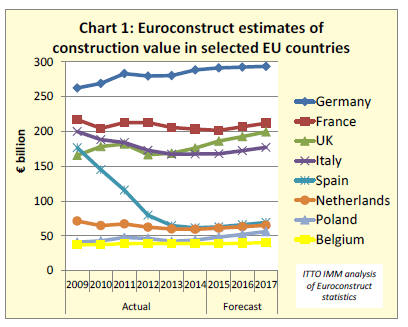
Amongst Europe&s largest construction markets, the UK is
showing the strongest upward trend, with Euroconstruct
forecasting growth of 5.7% in 2015 and 3.5% in both 2016
and 2017.
Recovery in Spain, Italy, the Netherlands and France is
also forecast to continue between 2015 and 2017. Output
in Germany, which recovered from the recession earlier
than other European countries, is forecast to stabilise at a
relatively high level.
The highest growth rates in the period 2015 to 2017 are
expected in Ireland and Poland, averaging 10.8% and
8.6% per year respectively. However, growth in Ireland
follows a dramatic fall of almost 70% between 2007 and
2013. Growth in Poland will be mainly the result of sharp
rises in civil engineering.
European wood flooring production down again in
2014
The European wood-flooring sector has yet to benefit from
the turnaround in the building industry. According to a
report by the Global Flooring Alliance, production of 求real
wood′ flooring (not including laminate flooring) in the 17
countries covered by the European Federation of the
Parquet Industry (FEP) 1 fell by 6.6% in 2014, after a
moderate decline of 1.8% in 2013 (Chart 2).
Production in FEP member countries fell from 67.04
million sq.m in 2013 to 62.80 million sq.m in 2014.
Production has fallen 37% from a peak of 100.33 million
sq.m in 2007.
The decline in wood flooring production in Europe as
whole, including countries not belonging to FEP, was less
dramatic. According to FEP data quoted by the Global
Flooring Alliance, production throughout the region fell
by only 1% to around 76 million sq.m in 2014.
1 Austria, Belgium, Czech Republic, Denmark, Finland,
France, Germany, Hungary, Italy, Netherlands, Norway,
Poland, Romania, Slovakia, Spain, Sweden and
Switzerland.
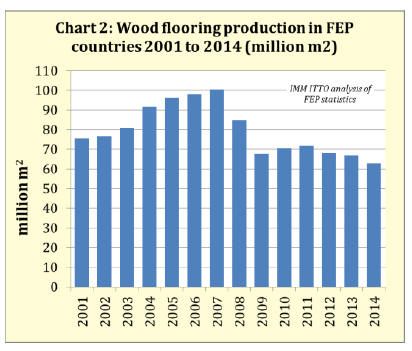
Consumption of wood flooring down 6.4% in 2014
Wood flooring consumption in the countries covered by
FEP showed a similar trend last year. Consumption
increased in only a handful of countries, including the
Netherlands, Hungary, Slovakia and Sweden. Overall
consumption in all FEP countries was down by 6.4% at
just over 77 million sq.m.
The finalised figures for 2014 are a disappointment to FEP
members who, at the FEP meeting in June 2014, suggested
that the outlook for real wood flooring in Europe was
improving and that demand should pick up in the second
half of 2014.
Hopes are that the improved level of consumption
registered in some northern European countries would
filter through into large southern European markets for
wood flooring failed to materialise.
EU wood flooring export trend swings negative
EU exports of wood flooring were rising in the five years
between 2009 and 2014, as manufacturers diversified into
new markets during a period of slow demand in Europe.
Exports increased by 4.7% to 17.707 million sq.m in 2013
and by another 2.7% to 18.179 million sq.m in 2014.
However, the positive export trend has slowed since the
last quarter of 2014. In the first quarter of 2015, EU wood
flooring exports were 4.174 million sq.m, 4.7% lower than
in the same period the previous year.
The decline in EU wood flooring exports in the first
quarter was primarily due to significantly lower deliveries
to Switzerland (-12.4%) and Norway (-11.4%), the two
largest European markets outside the EU (Chart 3).
This is surprising in the case of Switzerland. The Swiss
franc has gained considerably in value against the euro
since the end of last year when the Swiss currency was
untied from the euro exchange rate. Wood flooring
produced in the EU has therefore become much cheaper
for Swiss buyers.
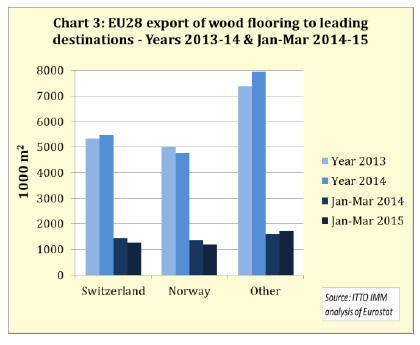
EU wood flooring exports to countries outside the EU
varied widely in the first quarter of 2015 (Chart 4).
Exports increased to the USA (+8.8%), Turkey (+27.2%)
and China (+2.9%) during this period.
Exports also continued to rise strongly to Canada
(+20.6%), Hong Kong (+26.3%), the United Arab
Emirates (+85%) and Israel (+26.1%) in the first quarter.
In contrast, the collapse in the value of the Russian rouble
led to a 31.7% decline in EU exports of wood flooring to
Russia in the first quarter of 2015. The unstable situation
in the Ukraine caused exports to this market to fall sharply
by 36.7% in 2014 and again by 45.3% in the first three
months of this year.

Wood flooring imports from China growing sharply
Imports of real wood flooring from outside the EU
declined in 2013 but started to recover in 2014. Total EU
real wood flooring imports in 2014 climbed by 10.4% to
22 million sq.m. This positive trend continued in the first
quarter of 2015, but at a much slower rate of growth.
Imports in the first quarter were 5.6 million sq.m, 1.2%
more than same period the previous year. Imports from
China continued to rise rapidly, up 10.3% in the period.
However these were offset by a 14.9% decline in imports
from all other countries (Chart 5).
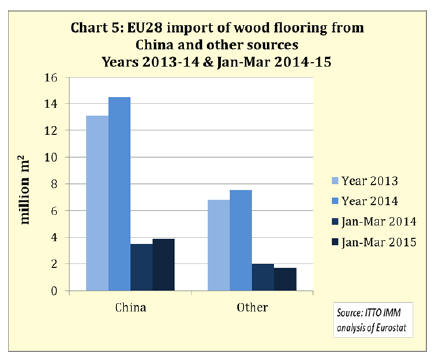
In the first quarter of 2015, EU imports were significantly
lower than the same period in 2014 from Ukraine (-4.4%),
Indonesia (-44.6%), Switzerland (-12.5%), Vietnam (-
22.4%), Serbia (-77.2%), and Norway (-27.4%). However
imports from Malaysia (+2.4%), Thailand (+47%) and
Turkey (+178%) all increased (Chart 6).
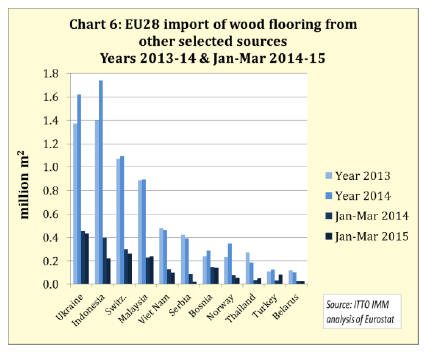
Slow recovery in European laminate flooring sales
continued in 2014
According to final figures published by the European
Producers of Laminate Flooring (EPLF) association,
laminate flooring sales by EPLF members increased
slightly by around 1% to 467 million sq.m last year.
Final sales were thus slightly higher than initial figures
published earlier this year, which put total sales in 2014 at
465 million sq.m.
Market conditions for laminate flooring manufactured in
Europe have varied widely by sales region. Chart 7
illustrates the importance of the different sales markets for
EPLF members.
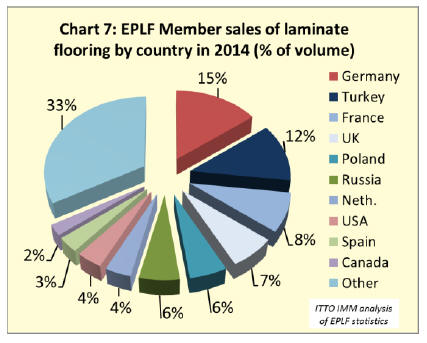
Sales in Germany, the largest single market, fell 4% to 69
million sq.m in 2014. EPLF believes that much of this
decline is due to a shift towards LVT flooring in Germany.
Sales to Turkey - the second largest target market for
EPLF members - fell by 13% to 57 million sq.m in 2014.
EPLF attributes this development to a weaker economic
situation, shortages in the supply of raw materials and the
temporary shutdown of production plants in Turkey.
EPLF member sales of laminate flooring in the important
French market stabilised at 39 million sq.m in 2014, the
same amount as the year before. However sales in the UK
increased by 10% to 32 million sq.m in 2014, boosted by
growth in construction sector activity and improving
consumer confidence. There was also a 4% increase in
sales in Spain to 14 million sq.m.
In Eastern Europe, EPFL members saw a much better
trend than in the west. Combined sales in this region rose
by 6.8% to 110 million sq.m.
Growth in Eastern Europe was primarily owing to strong
development in Russia, where sales increased by 19% to
28 million sq.m and Poland, which showed an
improvement of 6% at 26 million sq.m. Sales volumes in
Romania and Hungary were also higher than the year
before.
In North America, the positive trend that started in 2013
continued into 2014. Most of this growth was attributable
to the USA, where sales rose from 16 to 18 million sq.m.
Sales in Canada were practically unchanged in 2014 at
11.2 million sq.m.
In Asia, EPLF members booked a strong 15.4% increase
in sales to 15 million sq.m. EPLF member sales to China
increased by around 25% in 2014, but at 5 million sq.m
are still very small compared to the overall size of the
market.
Downward trend in laminate flooring sales in early
2015
According to a press release issued following the EPLF
annual general meeting in May, the market for laminate
flooring produced by EPLF members showed slight
decline in the first quarter of 2015 compared to the same
period the previous year.
In most cases, trends experienced by the individual
markets and regions in 2014 have continued this year.
Sales in Eastern Europe and Asia have continued to grow
and the downward trend in Western Europe has also
continued. However unlike last year, the North American
market has deteriorated slightly in the first three months of
this year.
The European market for laminate flooring is being
influenced this year by Turkey&s decision to impose antidumping
duties on laminate flooring imported from
Germany. EUWID reports that four German laminate
flooring manufacturers that cooperated in a Turkish antidumping
investigation launched in 2013 were assessed
individual anti-dumping duties.
All other German laminate flooring manufacturers have to
pay a punitive duty of US$1.05/sq.m. The duties took
effect upon publication of the ruling on 13 June 2015.
EPLF ※Task Force Russia§ has started working
European laminate flooring manufacturers have express
concern about alleged widespread counterfeiting of
products on sale in the Russian market.
In a statement last year, EPLF said that: 求the high
proportion of inferior-quality and incorrectly declared
goods imported from Asia [into Russia] makes things
difficult for EPFL manufacturers as it tends to cause
lasting damage to the image of laminate flooring′.
In response to these concerns, EPLF decided to set up a
so-called Task Force Russia. The first meeting of this
working group was held in March 2015 in Moscow.
It was decided that 求a technical working group of
companies who produce in Russia will set about
developing a new Russian GOST standard along the lines
of European standards′. Moreover, a second working
group will be established at a later date to actively
promote quality laminate flooring in Russia.
Quality, design and environmental performance to
create a competitive edge
At its annual general meeting EPFL announced new
initiatives to help ensure that European laminate flooring
maintains a 求leading role on the world markets′.
A new, generic Environmental Product Declaration for
laminate flooring was established in June, which 求sets a
new standard for the ecological quality of laminate
flooring′, according to EPLF.
In addition new test procedures for displaying
measurements on deeply structured laminate flooring were
also presented. Deeply structured surfaces create a 求rustic′
or 求used′ look that has dominated laminate flooring
design in recent times 每 mirroring the fashion for rustic
oak and other rustic wood surfaces in the real wood sector.
A first series of tests on deeply structured surfaces
conducted by IHD Wood Technology Institute in Dresden,
which examined the surfaces in highly trafficked areas,
found that deep structures do not wear faster than shallow
ones. According to EPLF, the so-called 求Test Abrader′
method for measuring abrasion resistance will be modified
accordingly.
EPLF also noted the need for the organisation to become
more actively involved in international communication
and promotion activities, particularly as the European
market for laminate flooring continues to show signs of
weakness in 2015.
|